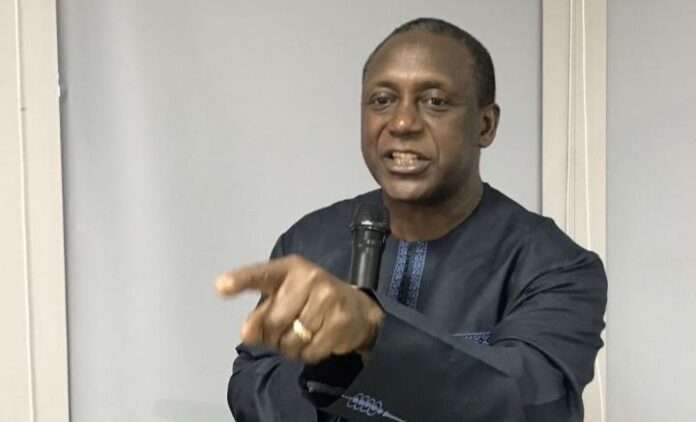By The Prowess
Residents across Freetown continue to endure frequent power outages, exposing long-standing structural and financial issues within Sierra Leone’s energy sector. Despite government efforts and significant investments, the city’s electricity supply remains erratic, frustrating citizens, business owners, and public institutions alike.
Power cuts in Freetown have become routine, with many reporting daily blackouts lasting from minutes to several hours and in some areas, even days. According to an Afrobarometer survey, only 11% of Sierra Leoneans receive electricity “most or all of the time,” and just about 31% are connected to the national grid.
The electricity crisis in Sierra Leone has prompted detailed commentary from Dr. Kandeh Kolleh Yumkella, Presidential Adviser on Energy. According to Dr. Yumkella, the country’s electricity generation capacity has increased significantly, rising from 130 megawatts (MW) in 2018 to approximately 270 MW by the end of 2024. Despite this growth, electricity demand continues to outpace supply. For instance, Freetown alone requires between 130 and 150 MW to meet its needs, yet it currently receives only 60 to 65 MW, which includes the 50 MW contribution from the Karpowership.
To address the crisis, Dr. Yumkella outlined a phased strategic roadmap. In the short term (within six months), the government plans to repair the Kingtom (9 MW) and Blackhall Road (16 MW) thermal stations, which are expected to collectively restore 26 MW by July. Additionally, the strategy includes boosting power imports: 10 MW from Guinea, 27 MW from Ivory Coast, and 50 MW from Ghana. There is also an urgent plan to recruit key technical officers for the Electricity Distribution and Supply Authority (EDSA) to enhance institutional capacity.
In the medium term (12 to 18 months), the focus will shift to commissioning new power plants in Newton, Kamakwei, and Lungi, alongside the expansion of solar energy projects. These initiatives are aimed at diversifying the energy mix and improving supply resilience.
Looking further ahead, the long-term strategy includes the development of a planned 83 MW gas-powered plant, upgrades to existing hydroelectric stations, the rollout of over 200 mini-grids across the country, and significant improvements to the transmission and distribution infrastructure.
Dr. Kandeh Kolleh Yumkella, Presidential Adviser on Energy, has emphasized the urgent need for comprehensive reforms within the Electricity Distribution and Supply Authority (EDSA). “We must make EDSA ten times better—more reliable, transparent, and efficient. Our people deserve that,” he stated, underscoring the government’s intent to improve service delivery. In early 2025, he conducted surprise inspections at key power plants to assess their operations and reassured the public that emergency repairs were underway to ease load shedding in the coming months.
The electricity crisis has had a severe impact on local businesses and residents. Solomon Bangura, a local entrepreneur, expressed his frustration: “We’re constantly losing business because of the power cuts. The cost of running a generator is high, and not everyone can afford it.” His sentiment is widely shared, as many Sierra Leoneans grapple with the high cost of self-generated power and frequent blackouts.
EDSA’s Director-General, Mr. Abu Kamara, attributed the frequent outages to a combination of seasonal challenges and infrastructure sabotage. “The dry season reduces water levels at Bumbuna Dam, and we also face major setbacks due to cable theft and vandalism,” he explained. EDSA estimates that Freetown requires about 100 MW of electricity, yet receives significantly less from regular sources. While emergency power partly fills the gap, aging infrastructure, inadequate maintenance, and limited capacity continue to undermine supply reliability.
Between late 2024 and early 2025, the government allocated between US$17–18 million to settle debts with Karpowership and sustain emergency electricity supply. Additionally, Sierra Leone signed regional energy agreements to import up to 87 MW of power. In response to worsening public dissatisfaction, President Julius Maada Bio placed the Ministry of Energy under direct oversight, assigning Dr. Yumkella a central role in reforming the energy sector.
Despite these interventions, public skepticism remains high. A 2024 investigation revealed that more than US$35 million had been paid to Karpowership within just seven months, yet electricity access showed little improvement. “I bought a new fridge just last month, and now it’s not working anymore. This power situation is hurting us,” lamented John Kargbo, a resident of Freetown, echoing the disappointment of many.
Nevertheless, the government has made some progress in the renewable energy sector. The 25 MW Baoma Solar Power Station is now operational and feeding electricity into the national grid. Looking ahead, the Bumbuna II Hydropower Project, with a capacity of 143 MW, is expected to come online by 2026. Several solar-hybrid mini-grid systems, including the Baomahun project, are also in the pipeline. However, the pace of implementation remains slow, and seasonal droughts continue to disrupt hydropower output.
Sierra Leone’s energy crisis is rooted in a complex mix of infrastructure decay, unreliable hydropower due to climate variability, chronic financial constraints, and weak institutional management. While short-term measures, such as foreign electricity imports and emergency debt repayments, have provided temporary relief, they have yet to deliver lasting solutions.
Experts propose a three-pronged approach to stabilize the national grid and ensure long-term energy security. First, expanding renewable energy sources, including solar, hydro, and mini-grid systems—is essential. Second, modernizing outdated infrastructure to reduce technical losses and prevent electricity theft must be prioritized. Third, governance reforms are critical: EDSA oversight needs strengthening, and contract transparency must be enforced.
As Abu Kamara rightly noted, “human interference” such as cable theft and illegal electricity connections continues to undermine efforts. This highlights the need for stronger community cooperation, public accountability, and civic education. The road to reliable electricity in Sierra Leone will not be easy, but with consistent investment, institutional reform, and active citizen engagement, the long-awaited “light at the end of the tunnel” may soon become an everyday reality for the people of Freetown.


